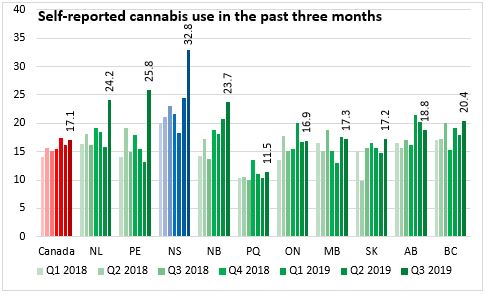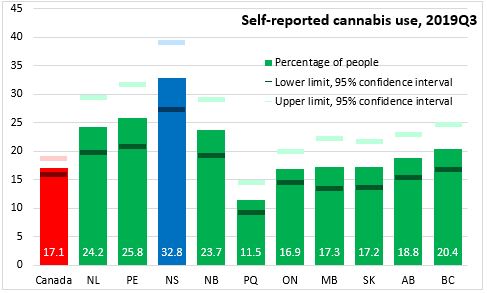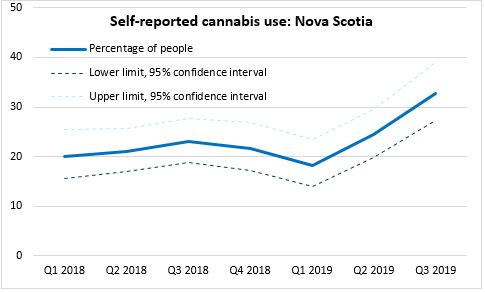The Economics and Statistics Division maintains archives of previous publications for accountability purposes, but makes no updates to keep these documents current with the latest data revisions from Statistics Canada. As a result, information in older documents may not be accurate. Please exercise caution when referring to older documents. For the latest information and historical data, please contact the individual listed to the right.
<--- Return to Archive
For additional information relating to this article, please contact:
October 30, 2019NATIONAL CANNABIS SURVEY, 2019Q3 Statistics Canada's National Cannabis Survey (NCS) results for 2019Q3 were released today. The NCS monitors cannabis consumption and related behaviours, with results available for every province.
Statistics Canada cautions that these results have some data limitations: "The information in this release is self-reported and has not been validated. Social desirability and fear of punishment, both of which are potential sources of bias, may be especially relevant to this analysis. Changes over time in respondents' willingness to admit drug use may be influencing the statistics but remains difficult to measure. Small sample sizes for some analyses may also have reduced the ability to reach statistical significance."
In 2019Q3, 17.1 per cent of Canadians aged 15+ (nearly 5.2 million) reported using cannabis in the last three months, measured from mid-August to mid-September. National cannabis use is up compared with 2018Q3, which was prior to legalization. Prevalence of cannabis use was significantly above the national average for all four Atlantic Provinces, with the greatest prevalence in Nova Scotia: 32.8 per cent. Prevalence of cannabis use in Quebec remains lower than the national average (11.5 per cent).

With a limited sample size for the NCS, there are confidence intervals around point estimates of usage. The point estimate of cannabis use is 17.1 per cent for Canada, but confidence intervals (a range over which 95 per cent of estimates would fall using different sample populations) ranges from 15.7 to 18.6 per cent.

Nova Scotia's self-reported cannabis usage in 2019Q3 (32.8 per cent) has a confidence interval ranging from 27.2 to 38.9 per cent. Smaller provinces with smaller sample sizes have wider confidence intervals.
Nova Scotia's prevalence rate of 32.8 per cent represents 260,600 cannabis users in 2019Q3. After remaining stable for much of 2018 (before legalization) and falling early this year, Nova Scotia's cannabis use has increased in the second and third quarters of 2019.

At a national level (combining Q2 and Q3 results), Statistics Canada reports that cannabis use is significantly higher for those aged 15-24 (26 per cent) and lower for those aged 65 and older (7 per cent). However, cannabis consumption is growing more rapidly for seniors than for other age cohorts, though their use is less frequent and more commonly attributed to medical (52 per cent report exclusive medical use with or without a medical document) rather than non-medical reasons.
Seniors are also the least likely to report acquiring cannabis from an illegal supplier at 23 per cent. This is lower than the 52 per cent illegal source cannabis for those aged 15-24, 43 per cent for those aged 25-44 and 39 per cent for those aged 45-64. Overall, sourcing cannabis from legal sources was up to 53 per cent of users in Q2 and Q3 of 2019; this is up from 23 per cent in the same period of 2018, prior to legalization. Users reporting acquisition of cannabis from illegal sources were down, including illegal dealers (down 10 percentage points to 42 per cent) and friends and family (down 10 percentage points to 39 per cent). Growing cannabis was reported as a source by 8 per cent of users.
Source: Statistics Canada. Table 13-10-0383-01 Prevalence of cannabis use in the past three months, self-reported;
<--- Return to Archive